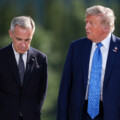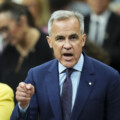We’re living in a microeconomic moment when Canadians are primarily focused on their personal economy even though the bigger, longer-term challenges facing the country are macroeconomic. A stagnant economy, low business investment, and flatlined productivity are secular threats to Canada’s long-run prosperity and wealth creation. This creates an inherent challenge for politicians who need to be responsive to Canadians’ immediate microeconomic concerns and still mindful of the country’s macroeconomic weaknesses.
The tension between the macro and the micro is manifesting itself at another level for the Conservatives. As their party undergoes a political realignment, its centre of gravity is shifting from a more traditional conservatism to a working-class populism. These new Conservative voters aren’t anti-conservative but they’re also not necessarily as committed to conservative economic orthodoxy as past ones. This has led the Conservative Party to move in some unconventional policy directions, including, for instance, its unexpected support for a legislative ban on replacement workers.
In both cases—the macro and the micro and conservatism and populism—the question is: are there certain policy areas that can enable a prospective Conservative government to square the circle?
Are there macroeconomic reforms that can produce microeconomic upsides? And traditional conservative reforms that also speak to populist concerns?
I’ve increasingly put this question to politicians, pollsters, academics, and think-tankers. It’s a difficult thought experiment. There isn’t a long list of obvious examples. But overwhelmingly—almost unanimously—they’ve pointed to competition reform—particularly for protected sectors like airlines, banking, and telecommunications.
As a matter of economic policy, opening up these industries would create more market-based competition, provide new sources of capital, and bring different business models and new technologies. It would also expand consumer choice and ostensibly put downward pressure on prices. At the level of conservatism and populism, it’s the type of policy reform that could in theory receive support from the C.D. Howe Institute and Canada Proud.
Of these different sectors, targeting telecommunications seems like the lowest-hanging fruit. The government has already liberalized foreign ownership restrictions for smaller players. All that’s left is to extend it more broadly across the industry.
It would then be important to bring expression to the principle of market-based competition throughout other telecommunications policies to ultimately support the goal of competition reform. As was recently set out in a Hub essay, this would involve liberalizing the current wholesale regime to better support facilities-based competition as well as shifting spectrum auctions to more of a market-based exercise and changing a slew of other policies that presently substitute bureaucratic diktats for market-driven outcomes.
Although it’s speculative to say what would happen if the telecoms sector was fully opened to competition, there’s reason to believe that it would pull new capital into the market on the one hand and reduce the asymmetry between industry players and Canadian consumers on the other hand. It would be pro-market and pro-consumer. And it would be conservative and populist.
These reforms of course have good macroeconomic pedigree. They’ve long been supported by economists and pro-efficiency wonks including in the 2008 Red Wilson Panel report. And in an era when polling tells us that Canadians are frustrated and switching their telecom providers, they’d also be well received as a programme of microeconomic or populist reform.
It reinforces a point that Cardus president Brian Dijkema made on a recent episode of Hub Dialogues. A realignment policy agenda for an incoming Conservative government will ostensibly look different in Canada than it will in the United States.
That partly reflects the fact that a lot of realignment ideas in the U.S.—including generous child benefits or low-income tax cuts or new middle-class savings vehicles—were already implemented by the previous Harper government which in hindsight can now be seen as a harbinger of the new Conservative realignment. It’s also however a function of Canada’s less dynamic and more closed market structure in which working-class consumers typically face fewer choices and higher prices. The upshot is that, as Dijkema put it, the tension between conservative orthodoxy and realignment policies may actually be less marked here than in the U.S.
As the Conservatives conceive of their policy platform, therefore, they should aim for a competition-driven consumerism that square the circle between the microeconomy and the macroeconomy and between traditional conservatism and modern populism. Liberalizing the telecommunications sector is a good start. It can lay the foundation for a broader set of policy reforms that are responsive to consumers in the short term and boost Canada’s economy over the long term.
This article was made possible by TELUS and the generosity of readers like you. Donate today.











